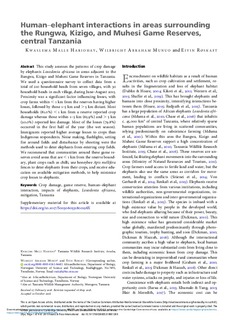| dc.contributor.author | Hariohay, Kwaslema Malle | |
| dc.contributor.author | Munuo, Wilbright Abraham | |
| dc.contributor.author | Røskaft, Eivin | |
| dc.date.accessioned | 2020-01-20T07:50:06Z | |
| dc.date.available | 2020-01-20T07:50:06Z | |
| dc.date.created | 2020-01-07T08:30:29Z | |
| dc.date.issued | 2019 | |
| dc.identifier.citation | Oryx. 2019, . | nb_NO |
| dc.identifier.issn | 0030-6053 | |
| dc.identifier.uri | http://hdl.handle.net/11250/2636900 | |
| dc.description.abstract | This study assesses the patterns of crop damage by elephants Loxodonta africana in areas adjacent to the Rungwa, Kizigo and Muhesi Game Reserves in Tanzania. We used a questionnaire survey to collect data from a total of 210 household heads from seven villages, with 30 household heads in each village, during June–August 2015. Proximity was a significant factor influencing losses, with crop farms within < 1 km from the reserves having higher losses, followed by those 1–5 km and > 5 km distant. Most households (81.0%) < 1 km from a reserve reported crop damage whereas those within 1–5 km (65.9%) and > 5 km (20.0%) reported less damage. Most of the losses (79.8%) occurred in the first half of the year (the wet season). Immigrants reported higher average losses to crops than Indigenous respondents. Noise making, flashlights, setting fire around fields and disturbance by shooting were the methods used to deter elephants from entering crop fields. We recommend that communities around these game reserves avoid areas that are < 1 km from the reserve boundary, plant crops such as chilli, use honeybee Apis mellifera fences to deter elephants from their crops, and receive education on available mitigation methods, to help minimize crop losses to elephants. | nb_NO |
| dc.language.iso | eng | nb_NO |
| dc.publisher | Cambridge University Press | nb_NO |
| dc.rights | Navngivelse-Ikkekommersiell-DelPåSammeVilkår 4.0 Internasjonal | * |
| dc.rights.uri | http://creativecommons.org/licenses/by-nc-sa/4.0/deed.no | * |
| dc.title | Human-elephant interactions in areas surrounding the Rungwa, Kizigo, and Muhesi Game Reserves, central Tanzania | nb_NO |
| dc.type | Journal article | nb_NO |
| dc.type | Peer reviewed | nb_NO |
| dc.description.version | publishedVersion | nb_NO |
| dc.source.pagenumber | 9 | nb_NO |
| dc.source.journal | Oryx | nb_NO |
| dc.identifier.doi | 10.1017/S003060531800128X | |
| dc.identifier.cristin | 1767269 | |
| dc.description.localcode | COPYRIGHT: © Fauna & Flora International 2019 This is an Open Access article, distributed under the terms of the Creative Commons Attribution-NonCommercial-ShareAlike licence (http://creativecommons.org/licenses/by-nc-sa/4.0/), which permits non-commercial re-use, distribution, and reproduction in any medium, provided the same Creative Commons licence is included and the original work is properly cited. The written permission of Cambridge University Press must be obtained for commercial re-use. | nb_NO |
| cristin.unitcode | 194,66,10,0 | |
| cristin.unitname | Institutt for biologi | |
| cristin.ispublished | true | |
| cristin.fulltext | original | |
| cristin.qualitycode | 1 | |

